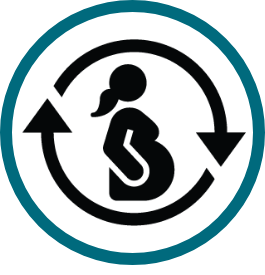65% of maternal deaths could be prevented, if all births occurred in health facilities.1 USAID: Ending Preventable Maternal Mortality: USAID Maternal Health Vision for Action
USAID
June 2014
This is a one-time behavior practiced at each birth.

Delivery in Health Facility
Pregnant women deliver in a health facility with an equipped, qualified provider
Key Points from Global Research
- Facilitating increased positive involvement and support by partners or close relatives of pregnant women can lead to improved planning for and higher rates of facility delivery.
- Improving both actual quality and potential clients’ perception of quality at maternal health clinics can increase a pregnant woman’s willingness and commitment to deliver in a health facility, despite long distances or other challenges.
Behavior Profile Sample: Delivery in Health Facility
A Behavior Profile is a summary analysis of each behavior. This sample draws from global evidence and illustrates the result of using the Create Behavior Profiles Tool to analyze factors, supporting actors and strategies and to ensure logical pathways exist between strategies proposed and factors related to the practice of the behavior. This sample may be used as a starting point or reference for creating Behavior Profiles.
| Improve maternal and child survival | |
|
Pregnant women deliver in a health facility with an equipped, qualified provider Indicator: Percentage of live births in the three years preceding the survey delivered at a health facility
|
Behavior Analysis |
Strategy | ||
|---|---|---|---|
STEPSWhat steps are needed to practice this behavior?
Click on any box |
FACTORSWhat factors may prevent or support practice of this behavior? These should be analyzed for each country context.StructuralAccessibility: Pregnant women do not deliver in a health facility, especially in an emergency, because facilities are often far from households and transportation is difficult to find Accessibility: Pregnant women are unable to deliver in a health facility because maternity care is not always free Service Provider Competencies: Pregnant women do not receive all required services from a health facility because they want to avoid negative provider attitudes and treatment Service Experience: Pregnant women cannot deliver in a health facility because not all clinics are open or staffed 24 hours SocialGender: Pregnant women do not have support from their partners to pursue and mobilize resources for delivery in a health facility because due to tradition, lack of information, lack of accommodation, and the exclusion of men in the maternal health system Norms: Pregnant women do not deliver in a facility because traditional birthing practices and preferences differ from experiences in clinics InternalAttitudes and Beliefs: Pregnant women choose to deliver at a health facility because they want a healthy baby Attitudes and Beliefs: Pregnant women do not deliver in a facility because many women perceive the quality of care from a clinic as no better than care from a traditional birth attendant at home |
SUPPORTING ACTORS AND ACTIONSWho must support the practice of this behavior?InstitutionalPolicymakers: Ensure affordability of care for most vulnerable via insurance schemes, CCTs, or other financing Policymakers: Review staffing policy to ensure maternity care is accessible 24 hours Managers: Explore ways to offer more of what women want for their delivery in clinic setting Providers: Offer respectful care to clients Providers: Actively engage men in pregnancy and delivery decisions CommunityCommunity Leaders: Support women with transport costs and logistics, including facilitation of community solutions like building maternity waiting shelters HouseholdMale Partners: Actively participate in childbirth related decisions and encourage partners to deliver in a facility |
POSSIBLE PROGRAM STRATEGIESHow might we focus our efforts based on this analysis?Enabling EnvironmentFinancing: Create national insurance schemes, use conditional cash transfers (CCTs) or establish community savings schemes to ensure all are able to access maternity services Partnerships and Networks: Expand delivery of labor and delivery as well as EMONC services beyond formal system via avenues like social franchising Policies and Governance: Strengthen human resources allocation to ensure 24 hour coverage at all EmONC sites and referral systems Policies and Governance: Allow non-harmful traditional birthing practices at clinics Systems, Products and ServicesInfrastructure: Explore creation of waiting shelters for mothers Quality Improvement: Ensure providers are well-trained in and offer respectful maternity care Demand and UseCommunication: Leverage traditional birth attendants for counseling, referrals and support to women and families in planning for and delivering in a facility, including distribution of birthing kits Communication: Use targeted media, including SMS where possible, to promote the improved quality of care and tailor reminders and tips for pregnant women and their families, self-created locally appropriate or picture-based birth plans Collective Engagement: Engage community leaders and men to diffuse responsibility for women's health care |
Global Status of Accelerator Behavior
Indicator: Percentage of live births in the three years preceding the survey delivered at a health facility
The DHS Program Indicator Data API, The Demographic and Health Surveys (DHS) Program


 The Manoff Group was acquired by JSI in 2022.
The Manoff Group was acquired by JSI in 2022.